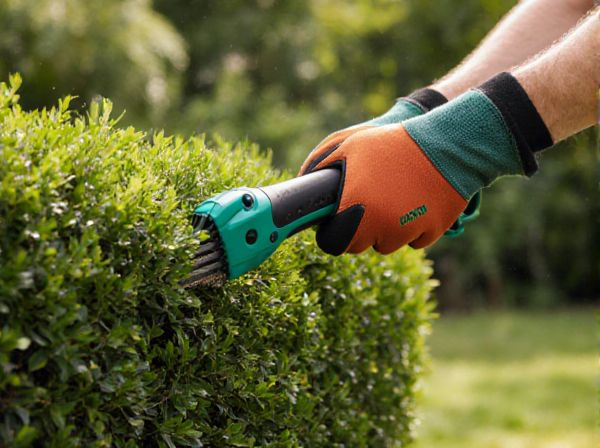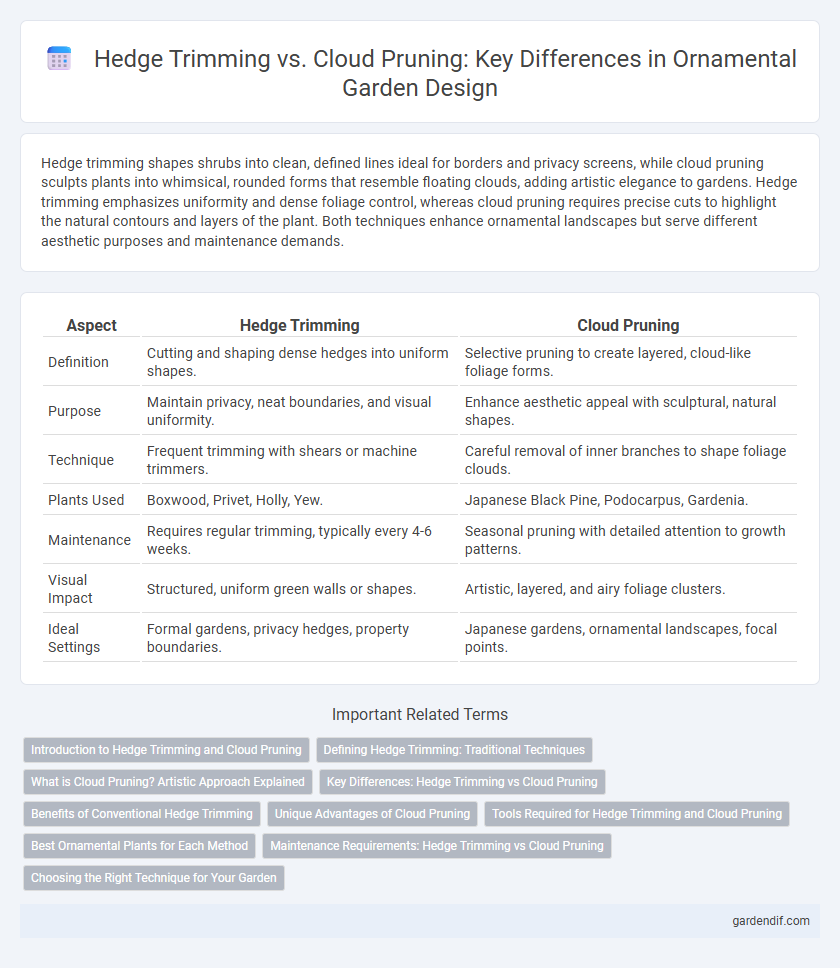
Hedge Trimming vs Cloud Pruning Illustration
Hedge trimming shapes shrubs into clean, defined lines ideal for borders and privacy screens, while cloud pruning sculpts plants into whimsical, rounded forms that resemble floating clouds, adding artistic elegance to gardens. Hedge trimming emphasizes uniformity and dense foliage control, whereas cloud pruning requires precise cuts to highlight the natural contours and layers of the plant. Both techniques enhance ornamental landscapes but serve different aesthetic purposes and maintenance demands.
Table of Comparison
| Aspect | Hedge Trimming | Cloud Pruning |
|---|---|---|
| Definition | Cutting and shaping dense hedges into uniform shapes. | Selective pruning to create layered, cloud-like foliage forms. |
| Purpose | Maintain privacy, neat boundaries, and visual uniformity. | Enhance aesthetic appeal with sculptural, natural shapes. |
| Technique | Frequent trimming with shears or machine trimmers. | Careful removal of inner branches to shape foliage clouds. |
| Plants Used | Boxwood, Privet, Holly, Yew. | Japanese Black Pine, Podocarpus, Gardenia. |
| Maintenance | Requires regular trimming, typically every 4-6 weeks. | Seasonal pruning with detailed attention to growth patterns. |
| Visual Impact | Structured, uniform green walls or shapes. | Artistic, layered, and airy foliage clusters. |
| Ideal Settings | Formal gardens, privacy hedges, property boundaries. | Japanese gardens, ornamental landscapes, focal points. |
Introduction to Hedge Trimming and Cloud Pruning
Hedge trimming shapes dense, uniform foliage to create clean, structured boundaries and enhance garden symmetry, commonly using shears or powered trimmers. Cloud pruning sculpts individual branches into rounded, cloud-like forms, emphasizing artistic expression and natural beauty, typically involving precise hand trimming. Both techniques elevate ornamental landscapes by balancing formality with aesthetic creativity.
Defining Hedge Trimming: Traditional Techniques
Hedge trimming involves shaping dense, permeable hedges using traditional techniques such as topiary shears or powered trimmers to maintain uniform height and width. This method emphasizes clean lines and consistent growth patterns, promoting healthy foliage and enhanced garden structure. Regular maintenance through hedge trimming also helps control plant size, preventing overgrowth and encouraging bushier, thicker leaves.
What is Cloud Pruning? Artistic Approach Explained
Cloud pruning is an artistic horticultural technique that shapes shrubs or trees into soft, rounded forms resembling clusters of clouds. This method enhances ornamental appeal by emphasizing natural beauty and grace, contrasting with the more structured and uniform appearance of traditional hedge trimming. Originating from Japanese topiary practices, cloud pruning requires precise, selective pruning to create layered, airy shapes that evoke a sense of harmony in garden design.
Key Differences: Hedge Trimming vs Cloud Pruning
Hedge trimming involves shaping dense, uniform foliage into clean, geometric lines to create formal boundaries or screens in gardens. Cloud pruning sculpts trees into rounded, layered shapes resembling fluffy clouds, emphasizing ornamental aesthetics and allowing light penetration. The key difference lies in hedge trimming's focus on uniformity and containment versus cloud pruning's artistic form and spatial openness.
Benefits of Conventional Hedge Trimming
Hedge trimming maintains dense, uniform growth that enhances garden structure and privacy, making it ideal for traditional landscaping designs. It supports plant health by removing dead or diseased branches, improving air circulation and sunlight penetration. This method is cost-effective and time-efficient for keeping hedges neatly shaped and manageable.
Unique Advantages of Cloud Pruning
Cloud pruning offers unique advantages over traditional hedge trimming by sculpting shrubs into airy, cloud-like shapes that enhance garden aesthetics with an artistic, three-dimensional quality. This technique improves plant health by increasing light penetration and air circulation within the foliage, reducing disease risk and promoting robust growth. Unlike straightforward hedge trimming, cloud pruning creates a stunning visual impact that integrates natural form with creative design, making it ideal for ornamental gardens and landscape artistry.
Tools Required for Hedge Trimming and Cloud Pruning
Hedge trimming primarily requires tools such as manual shears, electric trimmers, or petrol-powered hedge trimmers designed for shaping dense, uniform hedges. Cloud pruning demands precision tools including hand pruners, sharp secateurs, and sometimes specialized Japanese pruning saws to sculpt the distinct, rounded cloud shapes from ornamental trees. Selecting appropriate tools ensures clean cuts that promote healthy growth and enhance the aesthetic appeal of both hedges and cloud-pruned plants.
Best Ornamental Plants for Each Method
Hedge trimming excels with dense, evergreen plants such as boxwood, privet, and yew, which respond well to precise shaping and promote uniform growth. Cloud pruning is ideal for ornamental species with distinct, layered foliage like Japanese black pine, camellias, and azaleas, enhancing their natural cloud-like form. Selecting the right plant for each method ensures optimal aesthetic appeal and health in ornamental landscaping.
Maintenance Requirements: Hedge Trimming vs Cloud Pruning
Hedge trimming requires regular maintenance to maintain uniform shape and dense growth, typically involving frequent cuts throughout the growing season. Cloud pruning demands more specialized care, focusing on precise, artistic shaping that may require seasonal attention to preserve the distinct layered appearance. Both techniques necessitate consistent upkeep but differ in intensity and skill level, with cloud pruning often requiring more expert intervention.
Choosing the Right Technique for Your Garden
Hedge trimming provides clean, uniform shapes ideal for formal garden boundaries, while cloud pruning sculpts shrubs into whimsical, rounded forms that enhance ornamental appeal. Selecting the right technique depends on the desired garden style; hedge trimming suits structured designs, whereas cloud pruning adds artistic flair and focal interest. Proper timing and tool choice ensure healthy growth and the longevity of your garden's aesthetic.
Hedge Trimming vs Cloud Pruning Infographic

 gardendif.com
gardendif.com